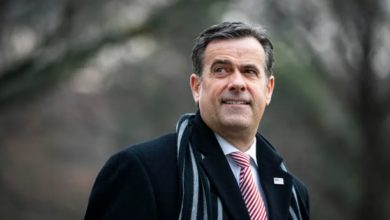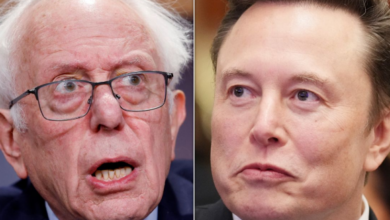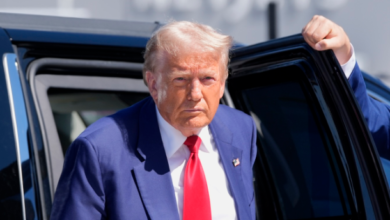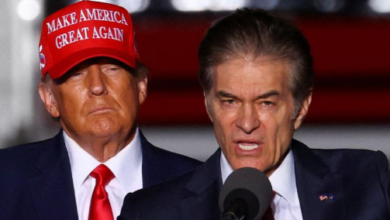Democratic Megadonors Sit On Sidelines Amid GOP Spending Blitz

Republican super PACs have massive fundraising and spending advantages over their Democratic counterparts entering the final weeks of the 2022 midterm elections. But the GOP’s edge among the mega-donor class is likely to go further in their efforts to win the House than in the battle for the Senate.
Democratic Senate candidates, who are mainly able to build national brands among the type of liberals who pour small donations into the party’s online coffers, built up sufficient war chests to fend off the GOP’s barrage of television spots, digital ads and hard-hitting mailers. Even if candidates like Rep. Tim Ryan in Ohio are still begging for additional help from the national party.
Their colleagues in the House, who were written off for much of the election cycle as having little chance to hold the chamber and are overshadowed by the battles for the Senate, do not appear to be so lucky. Republicans are pouring millions of dollars into even seats President Joe Biden won by double-digits two years ago, narrowing the Democrats’ already slender path to holding the majority.
The gap between the two adds yet another wrinkle to a cross-cutting and unpredictable midterm, defined by both Biden’s unpopularity, persistent inflation cutting into voter’s paychecks, and an unprecedented backlash to the Supreme Court’s decision to overturn Roe v. Wade that stripped away abortion rights.
The cash pouring into GOP super PAC coffers is extraordinary. The Congressional Leadership Fund, which focuses on the battle for the House, raised a whopping $73 million in the year’s third quarter. Its similarly-named counterpart for Congress’ upper chamber, Senate Leadership Fund, raised $111 million.
Neither of their Democratic counterparts has released their fundraising totals for the third quarter, but both have consistently trailed their GOP opponents. Super PACs, which are allowed to legally raise and spend unlimited sums as long as they do not directly coordinate with campaigns, typically raise their money in gobs of at least $10,000 a time and individual donations top $20 million with some frequency.
A Washington Post tally based on the most recent Federal Election Commission (FEC) reports found about 80% of the Congressional Leadership Fund’s cash comes from donations of $1 million or more, compared to just 49% for House Majority PAC. A HuffPost examination of the same data for the two Senate super PACs found similar results: Senate Leadership Fund had raised 76% of its cash in chunks of more than $1 million, compared to 50% for Senate Majority PAC.
So the failure of the Senate Majority PAC and House Majority PAC to keep pace with Republicans’ millions lies directly with the wealthiest group of Democratic donors.
“Biden has done such a great job this year,” said Leah Hunt-Hendrix, an oil heiress-turned-Democratic donor who founded the progressive group Way to Lead. “It’s so unfortunate that Democratic donors aren’t pouring money into super PACs to tell that story.”
Tim Persico, the executive director of the Democratic Congressional Campaign Committee, was blunt in an interview: His party’s candidates need big money, and they need it fast.
“It’s not my job to tell people what to do with their money,” he said, somewhat jokingly. “But if there are people who have supported Democratic causes, who believe that Kevin McCarthy is a danger to the survival of American democracy, and they have a couple of billion dollars, it would be super helpful for them to make a sizable contribution to HMP.”

Oleg Dubyna / 500px via Getty Images
The Candidate Rate
During an appearance on MSNBC’s “Rachel Maddow Tonight” on Tuesday, Sen. Gary Peters, the chair of the Democratic Senatorial Campaign Committee (DSCC), had a very different message for the party’s small-dollar donors: Keep doing what you’re doing.
“Right now, candidates raising individual money is critically important,” he said, repeatedly mentioning the name of a DSCC website directing small-dollar donors to individual candidates. “We’re focused on those races that are on a razor’s edge.”
Prognosticators continue to label the fight for control of the 50-50 Senate as a tossup, even if Democratic optimism has faded a bit from its summer highs. The party remains confident in Lt. Gov. John Fetterman’s chances against celebrity doctor Mehmet Oz in Pennsylvania. Wisconsin Lt. Gov. Mandela Barnes and former state Supreme Court Justice Cheri Beasley still have real shots to pick up GOP-held seats in Wisconsin and North Carolina.
Republicans, meanwhile, feel best about former state Attorney General Adam Laxalt’s chances to win against Democratic Sen. Catherine Cortez Masto in Nevada. And the race between Democratic Sen. Raphael Warnock and scandal-plagued Herschel Walker remains tight in Georgia. While their hopes have faded substantially in Arizona and New Hampshire, they are not writing off either state yet.
The post-Labor Day surge of spending from Republicans has substantially damaged Barnes and Fetterman. But it has not succeeded in dramatically altering the map in the GOP’s favor.
A major reason: Democratic money is simply going further than Republican money. By law, candidates can buy broadcast television airtime for the lowest possible price, while stations are free to charge substantially higher rates for outside groups like super PACs.
For example, a 30-second ad in Las Vegas, Nevada, costs just $598 for a candidate. But a super PAC or campaign committee would pay a much higher rate of $4,500, according to a media-buying source. The gaps are not super-sized everywhere — in Cleveland, candidates pay $385 compared to $800 for a super PAC — but the gains add up throughout millions of dollars and thousands of ads.
From the week of Labor Day through Oct. 10, Democratic campaigns and committees spent $140 million for 400,000 gross rating points — a measure of how many people will see an ad — in nine states contested by both parties, according to a media-buying source. Republicans, meanwhile, spent $150 million and only got 370,000 gross rating points of television airtime.
Arizona may see the starkest differences: Democratic Sen. Mark Kelly raised $23 million in the third quarter, far more than Republican Blake Masters’ $4.8 million. While several conservative groups are airing ads on Masters’ behalf, the GOP is far behind in the number of people seeing the spots.
Still, disagreements and worries about the party’s ability to keep up across the map cloud the big picture. Neither Senate Majority PAC nor the Democratic Senatorial Campaign Committee has spent cash backing Rep. Tim Ryan’s surprisingly persistent bid against Republican J.D. Vance in Ohio, even as the Senate Leadership Fund has poured in $28 million to prop up the former venture capitalist.
Ryan’s standing with the electorate has held up in recent weeks, despite expectations he would wilt under GOP pressure in a state former President Donald Trump won by healthy margins twice — and despite Barnes and Fetterman’s position weakening under a barrage of GOP attacks on crime.
“There’s no doubt that Ohio has been trending more Republican in recent years but candidate quality matters,” said Lis Smith, a Democratic campaign strategist who has advised Ryan in the past. “He faces the biggest spending disparity of any Senate candidate in the country, and he’s still tied with JD Vance.”
“Tim Ryan is a better insurance plan than some of the other Senate races on the map,” she added.
In Wisconsin, Barnes’ campaign and other Democratic efforts reached parity with GOP groups in recent weeks after being swamped during much of September. Barnes’ online fundraising has picked up, helping to offset the efforts of a super PAC funded by two in-state Republican mega-donors, Richard Uihlein and Diane Hendricks,
And in Pennsylvania, Fetterman’s team believes that a super PAC spending gap similarly hurt him in September, giving Oz’s allies the chance to paint him as soft on crime during a critical period.
The Senate Leadership Fund, the leading GOP Senate super PAC, was responsible for much of the effort, outspending the Senate Majority PAC by over $5.3 million on TV in September, according to ad purchasing data obtained by HuffPost. As a result, while Fetterman’s campaign outspent Oz’s on TV that month, the entire array of pro-Oz groups outspent pro-Fetterman groups by about $5.5 million.

Catherine McQueen via Getty Images
Red Money in Blue Territory
If Senate Democrats are holding their own, House Democrats are in a mild panic. According to a media-buying source, the party’s outside groups have been outspent by a nearly three-to-one margin from $217 million to $76 million. That gap is set to get smaller in the final weeks of the election when Democratic groups have $128 million reserved compared to Republicans’ $135 million.
But CLF’s massive cash reserves — it says it began the month of October with $114 million in the bank and added $15 million worth of new reservations on Thursday — mean the gap could only grow.
Their massive bank account has freed CLF to spend enormous sums targeting hard-to-dislodge Democratic incumbents, including Rep. Jared Golden of Maine and Reps. Matt Cartwright and Susan Wild of Pennsylvania. It’s also given them the freedom to aim even at some relative long-shots, spending in 10 seats Biden won by 10 percentage points or more. The strategy has forced Democrats to dedicate resources to safer seats that could otherwise be spent putting Republicans on the defensive.
“A key plank of our strategy this cycle has been to expand the map to as many competitive districts as possible,” Dan Conston, the president of Congressional Leadership Fund (CLF), said in a statement. “The net effect of that is that it forces the other side to make very difficult choices about who to fund and where their firewall is.”
For example, suppose Democrats had more resources. In that case, they might spend money to unseat Rep. Mike Garcia, a Republican in California’s 22nd, a Los Angeles-area seat where Biden won by 13 percentage points — roughly the same margin he won Colorado by. An immigration hawk opposed to abortion rights, Garcia has a voting record well to the right of more moderate Republicans in swing seats.
“Do donors know, is there a national consciousness around the fact that Mike Garcia is in a Biden double-digit seat and he is a far right-winger?” asked a veteran Democratic strategist active on House campaigns who requested anonymity to speak freely.
Part of the reason for the funding gap is that Democratic mega-donors wrote off the chances of holding the House early on in the election cycle. Republicans need to flip just five Democratic-held seats to take over the chamber after House Democrats’ unexpected losses in 2020.
Even if Democrats spent heavily and still lost the House, they would have the opportunity to narrow the size of Republicans’ majority and lay the groundwork for the 2024 cycle, Hunt-Hendrix noted. A larger Republican majority would be harder to undo in a presidential election cycle.
“What’s sad is that Democrats have this self-defeating mentality: ‘We’re going to lose the House, so we might as well not invest in it,’” she said.
But that pessimism did not account for the Supreme Court’s June ruling overturning a Constitutional right to abortion, which has energized Democratic voters and prompted attrition from independents and Republicans who support abortion rights. Democrats subsequently surprised observers with two special election wins in August: The first in a seat Biden narrowly carried in New York’s Hudson Valley and the second in Alaska’s at-large seat that Republicans had held for decades.
There are now more than 30 House seats that independent election watchers such as the Cook Political Report consider “toss-ups.” With the chance to flip a few GOP-held seats, such as Michigan’s 3rd and California’s 22nd, and fill an entirely new seat in Oregon’s 6th, Democrats now have a small but very real chance of holding the House.
“The conventional wisdom all cycle has been that we can’t save the House,” said Connor Farrell, the founder of the progressive fundraising firm Left Rising. “Now that there is a glimmer of hope, our donors need to be ready to move quickly and move big. We are seeing extremely close races that small differences in spending could determine. It’s go-time.”
Limited resources, however, mean that the party is poorly positioned to maximize its opportunities. For example, House Majority PAC canceled $435,000 worth of advertising in the Los Angeles media market earlier this week, money that could have gone towards attacking two vulnerable Republican members.
“If you’re trying to come up with a path to a Democratic majority, you have to give them some flips,” said Jacob Rubashkin, an analyst with the nonpartisan Inside Elections newsletter. “When you’re in a situation where HMP simply doesn’t have the money to go after California’s 22nd, a seat Biden won by 12 points, how are you possibly going to get back to 218 seats?”
A Branding Exercise
An e-mail from House Speaker Nancy Pelosi had the hectic, urgent tone recipients have come to expect from political fundraising missives.

Chip Somodevilla via Getty Images
“I’m in disbelief,” Pelosi wrote to the Democratic Congressional Campaign Committee’s (DCCC) e-mail list. She went on to write the following:
“In the wake of the Supreme Court’s apocalyptic vote to strike down Roe v. Wade, Republicans’ Senate leads have EVAPORATED:
– Herschel Walker is LOSING in Georgia.
– J.D. Vance is LOSING in Ohio.
– Dr. Oz is LOSING in Pennsylvania.
Now, Democrats are closer than EVER to dashing McConnell’s hopes of regaining power and eviscerating reproductive rights nationwide.”
The e-mail soon pivoted. “But please understand: While the polls predict Democrats can WIN these Senate seats, our House majority has never been more vulnerable,” Pelosi wrote.
But the simple fact that Pelosi’s e-mail needed to lead with news about the battle for the Senate — something fundraising emails from both her campaign and the DCCC has done repeatedly this cycle — shows how the high-profile, big-personality Senate fights have overshadowed House contests for the media and small and large donors alike.
“Democratic donors are obsessed with falling in love and obsessed with falling in hate. They like to go up against a villain,” the anonymous Democratic campaign strategist said. “But when [Democratic candidates are] more anonymous, you don’t focus on them in the same way.”
That’s especially a problem in House races where candidates are far less likely to have a national profile, the strategist added. While Ryan’s presidential run, Florida Rep. Val Demings’ mentions in the 2020 veepstakes and Fetterman’s frequent MSNBC appearances allowed their brands to appeal to liberal donors, it’s hard to do when you’re just one of 435 House candidates.
While 17 House Democratic challengers raised more than $1 million in the third quarter, compared to 10 House Republican challengers, they aren’t matching the massive sums House candidates like Pennsylvania Rep. Conor Lamb or Kentucky’s Amy McGrath did in 2018 and 2020 and aren’t developing the enormous advantages their Senate counterparts have.
The Senate candidates are popular enough with online donors that operatives working on those races are instead trying to fend off scam PACs hoping to leech off Democratic excitement. Brendon McPhillips, Fetterman’s campaign manager, has told donors not to give to the Democratic Coalition, a super PAC that infamously spends far more on fundraising costs than helping candidates.
The Democratic strategist contrasted Democratic big donors’ personality-focused mentality with the view of Republican donors, who have spent decades investing in under-the-radar state legislative and judicial races. They have been willing to stick with troubled candidates like Georgia’s Walker because they appreciate the policies at stake in controlling the Senate.
“They want to give to presidential campaigns. They want to have a splashy Bill Maher-style check to Priorities USA in a presidential campaign,” the strategist said. “They need to suck it up and realize, ‘It doesn’t matter. I’m an adult. I have the money. I care about Democrats winning, so every cycle, I give a big check.’ And you build that apparatus, that muscle memory, and then we have our own juggernaut that we need to compete.”
Other sources said some high-profile donors had focused more on state-level contests, including gubernatorial and secretary-of-state races, which could directly impact the 2024 presidential election. Perisco sympathized but emphasized the role the House could play in defending the American system.
“When you are fighting a 17-front war for the future of democracy, sometimes you do get a little distracted,” he said. “I am a Democrat first and a House Democrat second, so I also don’t really want like Nazi election deniers to be your Secretaries of State. So I do understand the impulse. But you know, Kevin McCarthy as speaker of the House is a pretty, pretty dangerous thing.”
[ad_2]
Source link





